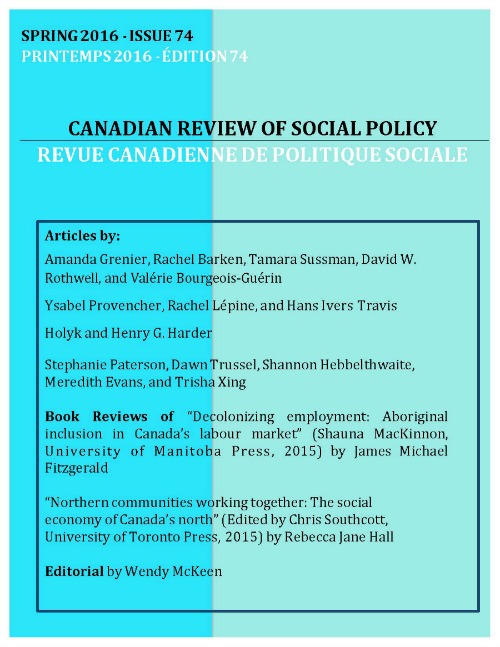Participation des personnes assistées sociales à la mesure de formation de la main d'oeuvre (MFOR): caractéristiques et résultats de fin de participation
Keywords:
aide sociale, mesure active d'emploiAbstract
La Mesure de formation de la main-d’œuvre (MFOR) représente l’une des mesures de la politique québécoise de l’emploi centrée sur le soutien à l’insertion professionnelle pour aider les personnes à intégrer le marché du travail et à s’y maintenir par le biais de l’acquisition de compétences en demande sur le marché du travail. Cet article présente un ensemble d’analyses effectuées à partir d’une banque de données administratives du ministère de l’Emploi et de la Solidarité sociale (MESS) portant sur la participation à la mesure MFOR entre 2005 et 2011. Cet article permet d’examiner de plus près l’effet de certains indicateurs socio-administratifs sur la fin de participation à la mesure chez les personnes assistées sociales ayant participé à la mesure de formation en comparant les caractéristiques de la participation des personnes qui ont complété les activités de formation par rapport à celles qui ne les ont pas complétées. Les résultats obtenus indiquent que chez les personnes assistées sociales, près de neuf participations sur dix sont relatives à la formation générale secondaire, à la formation professionnelle secondaire, à la francisation et à la formation technique collégiale. Les données indiquent également que plus le niveau de formation académique est avancé, plus le taux de participations complétées est élevé, et que le taux d’interruption des participations avant terme a augmenté entre 2005 et 2010. Enfin, parmi les individus inscrits à l’assistance et reconnus comme ayant une contrainte temporaire à l’emploi, le groupe des personnes de 55 ans et plus affiche des taux de participations complétées plus importants alors que le groupe des personnes ayant une contrainte santé affiche des taux d’interruption parmi les plus élevés.
Participation of social assistance recipients in la mesure de formation de la main-d’oeuvre (MFOR): Characteristics and results of end of participation
Abstract
The Emploi-Québec’s Manpower Training Measure (MFOR) is one of the measures in Quebec’s labour policy centered on supporting professional integration to help people integrate into the labour force and acquire the necessary skills for participation. This article examines a set of analysis based on administrative data obtained through le ministère de l’Emploi et de la solidarité sociale (MESS) on the participation to MFOR between 2005 and 2011. This article allows us to examine with more depth the socio-administrative indicators to ending participation to the MFOR for people on social assistance. We compare the participation characteristics of people who have completed the MFOR with those who failed to complete it. The results obtained reveal that among those who are on social assistance, 9 out of 10 participants received general secondary education training, professional secondary education training, French-language training, and professional college training. The results also indicate that the higher a participant’s academic level, the higher the rate of completion, and that the amount of people leaving the program has increased between 2005 and 2011. Finally, among participants who indicate having a temporary constraint to employment, those 55 and over have higher completion rates than those in the same age range that have a permanent health constraint to employment.
Keywords : social assistance; active employment measure
Published
How to Cite
Issue
Section
License
1-The author guarantees that the manuscript is an original work not published elsewhere in print or electronically in whole or in part, except in abstract form, that the author has the full power to make this contribution, and that the manuscript contains no matter libelous or otherwise unlawful or which invades the right of privacy or which infringes any proprietary right.
2-The author guarantees that the manuscript has not been previously published in print or electronically and that if the manuscript contains any tables, figures or images fully reproduced or closely adapted from previously published material, the author must obtain the necessary permission from the author/publisher holding the original copyright prior to publication in CRSP. The author may be required to produce evidence of permission granted to CRSP’s editors.
3-As a condition of publication in CRSP, the author assigns all copyright to CRSP, including but not limited to the right to publish, republish, and otherwise distribute this manuscript in print, electronic, or other formats. As CRSP is a non-profit interdisciplinary scholarly journal, the author will receive no royalty or other monetary compensation for the assignment set forth in this agreement.
For the purpose of full disclosure, CRSP will not normally use the content provided by the author in a commercial venture, but for the purpose of disseminating the author’s content to as many readers as possible. For distribution, third parties engaging in commercial activities may be contracted to distribute the content globally, and such parties may make a profit out of the author’s content in their normal course of business. CRSP will not pay the author or reimburse the author in any form based on such commercial activities because the conduct of such commercial activities is outside the control of CRSP.
Any future reference to or use of this published material by the authors must acknowledge CRSP as the original place of publication.
PERMISSION REQUEST/ARCHIVING
Permission is given to author(s) receiving funding via Tri-Council Agencies, the Canadian Institutes of Health Research (CIHR), the Natural Sciences and Engineering Research Council of Canada (NSERC) and the Social Sciences and Humanities Research Council (SSHRC), to make their publications freely available in an Open Access repository within the stated deadline by the Tri-Council Agencies (12 months following publication). Archiving of publication must be a manuscript copy bearing none of the CRSP headers, footers or any other distinguishing marks. No links to the article on the CRSP website is permitted.
Permission requests from third parties to reproduce articles in part or full in academic/educational publications can be directed to the managing editor of CRSP, and will not be unreasonably denied.

